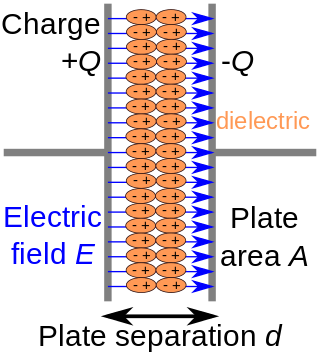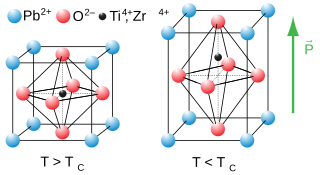Related Research Articles

In electromagnetism, a dielectric is an electrical insulator that can be polarised by an applied electric field. When a dielectric material is placed in an electric field, electric charges do not flow through the material as they do in an electrical conductor, because they have no loosely bound, or free, electrons that may drift through the material, but instead they shift, only slightly, from their average equilibrium positions, causing dielectric polarisation. Because of dielectric polarisation, positive charges are displaced in the direction of the field and negative charges shift in the direction opposite to the field. This creates an internal electric field that reduces the overall field within the dielectric itself. If a dielectric is composed of weakly bonded molecules, those molecules not only become polarised, but also reorient so that their symmetry axes align to the field.
Ferroelectricity is a characteristic of certain materials that have a spontaneous electric polarization that can be reversed by the application of an external electric field. All ferroelectrics are also piezoelectric and pyroelectric, with the additional property that their natural electrical polarization is reversible. The term is used in analogy to ferromagnetism, in which a material exhibits a permanent magnetic moment. Ferromagnetism was already known when ferroelectricity was discovered in 1920 in Rochelle salt by Joseph Valasek. Thus, the prefix ferro, meaning iron, was used to describe the property despite the fact that most ferroelectric materials do not contain iron. Materials that are both ferroelectric and ferromagnetic are known as multiferroics.
In chemistry, titanate usually refers to inorganic compounds composed of titanium oxides, or oxides containing the titanium element. Together with niobate, titanate salts form the Perovskite group.

Strontium titanate is an oxide of strontium and titanium with the chemical formula SrTiO3. At room temperature, it is a centrosymmetric paraelectric material with a perovskite structure. At low temperatures it approaches a ferroelectric phase transition with a very large dielectric constant ~104 but remains paraelectric down to the lowest temperatures measured as a result of quantum fluctuations, making it a quantum paraelectric. It was long thought to be a wholly artificial material, until 1982 when its natural counterpart—discovered in Siberia and named tausonite—was recognised by the IMA. Tausonite remains an extremely rare mineral in nature, occurring as very tiny crystals. Its most important application has been in its synthesized form wherein it is occasionally encountered as a diamond simulant, in precision optics, in varistors, and in advanced ceramics.

Lead zirconate titanate, also called lead zirconium titanate and commonly abbreviated as PZT, is an inorganic compound with the chemical formula Pb[ZrxTi1−x]O3(0 ≤ x ≤ 1).. It is a ceramic perovskite material that shows a marked piezoelectric effect, meaning that the compound changes shape when an electric field is applied. It is used in a number of practical applications such as ultrasonic transducers and piezoelectric resonators. It is a white to off-white solid.
In electromagnetism, electrostriction is a property of all electrical non-conductor or dielectrics. Electrostriction causes these materials to change their shape under the application of an electric field. It is the dual property to magnetostriction.
Electroceramics are a class of ceramic materials used primarily for their electrical properties.

Barium titanate (BTO) is an inorganic compound with chemical formula BaTiO3. Barium titanate appears white as a powder and is transparent when prepared as large crystals. It is a ferroelectric, pyroelectric, and piezoelectric ceramic material that exhibits the photorefractive effect. It is used in capacitors, electromechanical transducers and nonlinear optics.

A ceramic capacitor is a fixed-value capacitor where the ceramic material acts as the dielectric. It is constructed of two or more alternating layers of ceramic and a metal layer acting as the electrodes. The composition of the ceramic material defines the electrical behavior and therefore applications. Ceramic capacitors are divided into two application classes:
Lead scandium tantalate (PST) is a mixed oxide of lead, scandium, and tantalum. It has the formula Pb(Sc0.5Ta0.5)O3. It is a ceramic material with a perovskite structure, where the Sc and Ta atoms at the B site have an arrangement that is intermediate between ordered and disordered configurations, and can be fine-tuned with thermal treatment. It is ferroelectric at temperatures below 270 K (−3 °C; 26 °F), and is also piezoelectric. Like structurally similar lead zirconate titanate and barium strontium titanate, PST can be used for manufacture of uncooled focal plane array infrared imaging sensors for thermal cameras.
The Burns temperature, Td, is the temperature where a ferroelectric material, previously in paraelectric state, starts to present randomly polarized nanoregions, that are polar precursor clusters. This behaviour is typical of several, but not all, ferroelectric materials, and was observed in lead titanate (PbTiO3), potassium niobate (KNbO3), lead lanthanum zirconate titanate (PLZT), lead magnesium niobate (PMN), lead zinc niobate (PZN), K2Sr4(NbO3)10, and strontium barium niobate (SBN), Na1/2Bi1/2O3 (NBT).

Barium borate is an inorganic compound, a borate of barium with a chemical formula BaB2O4 or Ba(BO2)2. It is available as a hydrate or dehydrated form, as white powder or colorless crystals. The crystals exist in the high-temperature α phase and low-temperature β phase, abbreviated as BBO; both phases are birefringent, and BBO is a common nonlinear optical material.
Ferroelectric ceramics is a special group of minerals that have ferroelectric properties: the strong dependence of the dielectric constant of temperature, electrical field, the presence of hysteresis and others.

Strontium barium niobate is the chemical compound SrxBa1−xNb2O6 for 0.32≤x≤0.82.
A complex oxide is a chemical compound that contains oxygen and at least two other elements. Complex oxide materials are notable for their wide range of magnetic and electronic properties, such as ferromagnetism, ferroelectricity, and high-temperature superconductivity. These properties often come from their strongly correlated electrons in d or f orbitals.
Sodium bismuth titanate or bismuth sodium titanium oxide (NBT or BNT) is a solid inorganic compound of sodium, bismuth, titanium and oxygen with the chemical formula of Na0.5Bi0.5TiO3 or Bi0.5Na0.5TiO3. This compound adopts the perovskite structure.

Kenji Uchino is an American electronics engineer, physicist, academic, inventor and industry executive. He is currently a professor of Electrical Engineering at Pennsylvania State University, where he also directs the International Center for Actuators and Transducers at Materials Research Institute. He is the former associate director at The US Office of Naval Research – Global Tokyo Office.
Lead magnesium niobate is a relaxor ferroelectric. It has been used to make piezoelectric microcantilever sensors.
Nickel niobate is a complex oxide which as a solid material has found potential applications in catalysis and lithium batteries.
References
- ↑ Bokov, A. A.; Ye, Z. -G. (2006). "Recent progress in relaxor ferroelectrics with perovskite structure". Journal of Materials Science. 41 (1): 31. Bibcode:2006JMatS..41...31B. doi:10.1007/s10853-005-5915-7. S2CID 189842194.
- ↑ Takenaka, H.; Grinberg, I.; Rappe, A. M. (2013). "Anisotropic Local Correlations and Dynamics in a Relaxor Ferroelectric". Physical Review Letters. 110 (14): 147602. arXiv: 1212.0867 . Bibcode:2013PhRvL.110n7602T. doi:10.1103/PhysRevLett.110.147602. PMID 25167037. S2CID 9758988.
- ↑ Ganesh, P.; Cockayne, E.; Ahart, M.; Cohen, R. E.; Burton, B.; Hemley, Russell J.; Ren, Yang; Yang, Wenge; Ye, Z.-G. (2010-04-05). "Origin of diffuse scattering in relaxor ferroelectrics". Physical Review B. 81 (14): 144102. arXiv: 0908.2373 . Bibcode:2010PhRvB..81n4102G. doi:10.1103/PhysRevB.81.144102. S2CID 119279021.
- ↑ Phelan, Daniel; Stock, Christopher; Rodriguez-Rivera, Jose A.; Chi, Songxue; Leão, Juscelino; Long, Xifa; Xie, Yujuan; Bokov, Alexei A.; Ye, Zuo-Guang (2014). "Role of random electric fields in relaxors". Proceedings of the National Academy of Sciences. 111 (5): 1754–1759. arXiv: 1405.2306 . Bibcode:2014PNAS..111.1754P. doi: 10.1073/pnas.1314780111 . ISSN 0027-8424. PMC 3918832 . PMID 24449912.
- ↑ Hitchings, Thomas J.; Wickens, Helen M.; Peat, George U. L.; Hodgkinson, Paul; Srivastava, Anant Kumar; Lu, Teng; Lui, Yun; Piltz, Ross O.; Demmel, Franz; Phillips, Anthony E.; Saines, Paul J. (2023). "A new avenue to relaxor-like ferroelectric behaviour found by probing the structure and dynamics of [NH3NH2]Mg(HCO2)3". Journal of Materials Chemistry C. 11 (28): 9695–9706. doi: 10.1039/D3TC00480E .
- ↑ Bokov, A. A.; Ye, Z. -G. (2006). "Recent progress in relaxor ferroelectrics with perovskite structure". Journal of Materials Science. 41 (1): 31–52. Bibcode:2006JMatS..41...31B. doi:10.1007/s10853-005-5915-7. S2CID 189842194.
- ↑ Shipman, Matt (20 February 2018). "Atomic Structure of Ultrasound Material Not What Anyone Expected". NC State News.
- ↑ Cabral, Matthew J.; Zhang, Shujun; Dickey, Elizabeth C.; LeBeau, James M. (19 February 2018). "Gradient chemical order in the relaxor Pb(MgNb)O". Applied Physics Letters. 112 (8): 082901. Bibcode:2018ApPhL.112h2901C. doi:10.1063/1.5016561.
- ↑ and, and (September 1988). "Lead magnesium niobate relaxor ferroelectric ceramics of low-firing for multilayer capacitors". Proceedings., Second International Conference on Properties and Applications of Dielectric Materials. pp. 125–128 vol.1. doi:10.1109/ICPADM.1988.38349. S2CID 137495812.
- 1 2 Brown, Emery; Ma, Chunrui; Acharya, Jagaran; Ma, Beihai; Wu, Judy; Li, Jun (2014-12-24). "Controlling Dielectric and Relaxor-Ferroelectric Properties for Energy Storage by Tuning Pb0.92La0.08Zr0.52Ti0.48O3 Film Thickness". ACS Applied Materials & Interfaces. 6 (24): 22417–22422. doi:10.1021/am506247w. ISSN 1944-8244. OSTI 1392947. PMID 25405727.
- ↑ Drnovšek, Silvo; Casar, Goran; Uršič, Hana; Bobnar, Vid (2013-10-01). "Distinctive contributions to dielectric response of relaxor ferroelectric lead scandium niobate ceramic system". Physica Status Solidi B. 250 (10): 2232–2236. Bibcode:2013PSSBR.250.2232B. doi:10.1002/pssb.201349259. ISSN 1521-3951. S2CID 119554924.
- 1 2 Zhao, Peiyao; Wang, Hongxian; Wu, Longwen; Chen, Lingling; Cai, Ziming; Li, Longtu; Wang, Xiaohui (2019). "High-Performance Relaxor Ferroelectric Materials for Energy Storage Applications". Advanced Energy Materials. 9 (17): 1803048. doi:10.1002/aenm.201803048. ISSN 1614-6840. S2CID 107988812.
- ↑ Ortega, N; Kumar, A; Scott, J F; Chrisey, Douglas B; Tomazawa, M; Kumari, Shalini; Diestra, D G B; Katiyar, R S (2012-10-10). "Relaxor-ferroelectric superlattices: high energy density capacitors". Journal of Physics: Condensed Matter. 24 (44): 445901. Bibcode:2012JPCM...24R5901O. doi:10.1088/0953-8984/24/44/445901. ISSN 0953-8984. PMID 23053172. S2CID 25298142.